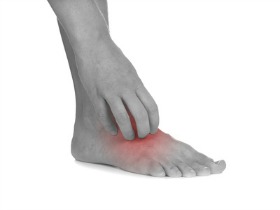Tinea Pedis - Athlete's Foot Rash
Visit this
PICTURES OF RASHES PAGE
Tinea pedis is the scientific name for the foot rash known as athletes foot. Unfortunately, athlete foot skin rash can be very uncomfortable for many people, but this foot rash can be easily cured and prevented with proper treatment and following some basic precautions.
Why does athlete’s foot rash or tinea pedis occur?
The reason athletes foot occurs is because the feet are prime candidates for skin related problems. Feet are often covered with shoes and/or synthetic socks and the skin on the feet is not able to “breathe”. The skin on the feet is also in the dark much of the time. Feet sweat often, especially when temperatures are warm or during physical activity. This leads to moist skin for much of the day because shoes, boots, etc., retain moisture. If footwear is not allowed to properly dry out from one day to the next, then the feet will always be subjected to a moist environment. Another factor is that the skin on the feet and in between the toes is often not properly and regularly cleaned and when cleaned, not properly dried.

All these factors lead to the development of athletes foot, which is caused by the growth of a fungus on the skin under warm, moist, and dark conditions. This skin rash problem can be spread to other people, especially in shared public places such as showers, locker rooms, saunas, and swimming pools. Athletes foot may also be spread to other body parts and create a skin rash in those areas. Spreading of athlete foot can occur because of direct contact with the affected skin area or the foot rash can be spread via indirect contact with contaminated surfaces or clothing.
Symptoms
Symptoms of this type of foot rash include the following: burning sensation and itching of the feet, especially between the toes; inflamed and red skin; foot odor; the appearance of blisters on the skin; cracked skin; thick and scaly skin; skin that frequently peels; dry skin; unhealthy toe nail appearance – thick, discolored, ragged, and crumbly.
Tinea Pedis Treatments
Treatment involves the use of anti-fungal sprays, powders, creams, or lotions that are available over the counter. More advanced tinea may require a visit to a physician if the condition does not clear in a week or two. In these situations, prescription topical treatments or even oral medications may be remedy required. Prevention is also important. Avoid the triggers of athlete's foot mentioned above.
A foot rash may be due to other reasons, such as eczema, psoriasis, dermatitis, allergic reaction to food, allergic reaction to plants such as poison ivy, allergies to various components in footwear such as dyes, or insect bites. These should be taken into account before assuming the skin problem is tinea pedis.
Other fungal type skin rashes:
ringworm | tinea versicolor | more rash types
